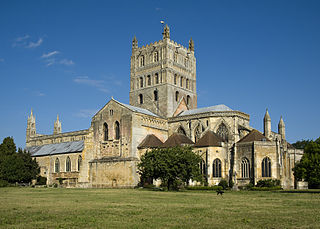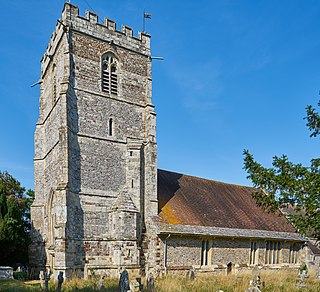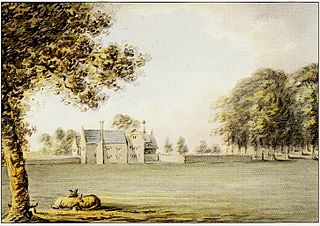Related Research Articles

The Abbey Church of St Mary the Virgin, Tewkesbury, commonly known as Tewkesbury Abbey, is located in the town of Tewkesbury in the ceremonial county of Gloucestershire, England. A former Benedictine monastery, it is now a parish church. Considered one of the finest examples of Norman architecture in Britain, it has the largest Romanesque crossing tower in Europe.

Sherborne Abbey, otherwise the Abbey Church of St. Mary the Virgin, is a Church of England church in Sherborne in the English county of Dorset. It has been a Saxon cathedral (705–1075), a Benedictine abbey church (998–1539), and since 1539, a parish church.

Sherborne is a market town and civil parish in north west Dorset, in South West England. It is sited on the River Yeo, on the edge of the Blackmore Vale, 6 miles east of Yeovil. The parish includes the hamlets of Nether Coombe and Lower Clatcombe. The A30 road, which connects London to Penzance, runs through the town. In the 2011 census the population of Sherborne parish and the two electoral wards was 9,523. 28.7% of the population is aged 65 or older.

Shaftesbury Abbey was an abbey that housed nuns in Shaftesbury, Dorset. It was founded in about 888, and dissolved in 1539 during the English Reformation by the order of Thomas Cromwell, minister to King Henry VIII. At the time it was the second-wealthiest nunnery in England, behind only Syon Abbey.

Cranborne is a village in East Dorset, England. At the 2011 census, the parish had a population of 779, remaining unchanged from 2001.

Thetford Priory is a Cluniac monastic house in Thetford, Norfolk, England. Founded in 1103 by Roger Bigod of Norfolk, Thetford was one of the most important monasteries of East Anglia.

Thorney Abbey, now the Church of St Mary and St Botolph, was a medieval monastic house established on the island of Thorney in The Fens of Cambridgeshire, England.

Cerne Abbey was a Benedictine monastery founded in 987 in the town now called Cerne Abbas, Dorset, by Æthelmær the Stout.

Tavistock Abbey, also known as the Abbey of Saint Mary and Saint Rumon, is a ruined Benedictine abbey in Tavistock, Devon. Nothing remains of the abbey except the refectory, two gateways and a porch. The abbey church, dedicated to Our Lady and St Rumon, was destroyed by Danish raiders in 997 and rebuilt under Lyfing, the second abbot. The church was further rebuilt in 1285 and the greater part of the abbey between 1457 and 1458.
Amesbury Abbey was a Benedictine abbey of women at Amesbury in Wiltshire, England, founded by Queen Ælfthryth in about the year 979 on what may have been the site of an earlier monastery. The abbey was dissolved in 1177 by Henry II, who founded in its place a house of the Order of Fontevraud, known as Amesbury Priory.
Events from the 1530s in England.

Athelney Abbey, established in the county of Somerset, England, was founded by King Alfred in 888, as a religious house for monks of the Order of St. Benedict. It was dedicated to "Our Blessed Saviour, St. Peter, St. Paul, and St. Egelwine".
Sir John Horsey was a knight of Henry VIII and Lord of the Manor of Clifton Maubank. He was also a friend of the poet Thomas Wyatt.

Forde Abbey is a privately owned former Cistercian monastery in Dorset, England, with a postal address in Chard, Somerset. The house and gardens are run as a tourist attraction while the 1,600-acre (650 ha) estate is farmed to provide additional revenue. Forde Abbey is a Grade I listed building.

Cowick is a suburb of the City of Exeter in Devon. Historically it was a manor situated in the parish of St Thomas, Exeter, within the hundred of Wonford. It was formerly the site of a Benedictine monastery.
Loders Priory was a priory in Loders, Dorset, England.

St Osyth's Abbey was a house of Augustine Canons Regular in the parish of St Osyth in Essex, England in use from the 12th to 16th centuries. Founded by Richard de Belmeis, Bishop of London, c. 1121, it became one of the largest religious houses in Essex. It was dedicated to Saints Peter and Paul as well as St Osyth (Osith), a royal saint and virgin martyr. Bishop Richard obtained the arm bone of St Osyth from Aylesbury for the monastic church and granted the canons the parish church of St Osyth.

Deeping St James Priory was a priory in Deeping St James, Lincolnshire, England. It was a dependency of Thorney Abbey.
Longleat Priory was a priory near Warminster, Wiltshire, in the south of England. A short-lived priory was established and dissolved near to Longleat in the 12th century. The main priory was established before 1233 and was under the control of the Dean of Salisbury until its dissolution in 1529.
References
- 1 2 Monasticon Anglicanum...a History of the Abbies and Other Monasteries...and Cathedral and Collegiate Churches...in England and Wales. Bohn. 1846. p. 511.
- 1 2 3 Page, William (1908). "Houses of Benedictine monks: The priories of Cranbourne and Horton". A History of the County of Dorset: Volume 2. London: Accessed via British History Online. pp. 70–73. Retrieved 26 August 2016.
- ↑ Pat. 14 Edw. I, m. 18, 19.
- ↑ 22 Edw. III, pt. 1, m. 43 d.
- ↑ Cal. Pap. Letters, v, 362.
- 1 2 Dugdale, Mon. ii, 511.
- ↑ P.R.O. Deeds of Surrender, No. 40; L. and P. Hen. VIII, xiv (i), 556.
50°52′00″N1°57′31″W / 50.866545°N 1.958522°W